Islamic Homosexualities : Culture, History, and Literature / ed. by Stephen O. Murray, Will Roscoe.
Material type: TextPublisher: New York, NY : New York University Press, [2020]Copyright date: ©1997Description: 1 online resourceContent type:
TextPublisher: New York, NY : New York University Press, [2020]Copyright date: ©1997Description: 1 online resourceContent type: - 9780814774670
- 9780814761083
- 306/.62/0917671
- HQ76.3.I75 M87 1997
- online - DeGruyter
| Item type | Current library | Call number | URL | Status | Notes | Barcode | |
|---|---|---|---|---|---|---|---|
 eBook
eBook
|
Biblioteca "Angelicum" Pont. Univ. S.Tommaso d'Aquino Nuvola online | online - DeGruyter (Browse shelf(Opens below)) | Online access | Not for loan (Accesso limitato) | Accesso per gli utenti autorizzati / Access for authorized users | (dgr)9780814761083 |
restricted access online access with authorization star
http://purl.org/coar/access_right/c_16ec
The dramatic impact of Islamic fundamentalism in recent years has skewed our image of Islamic history and culture. Stereotypes depict Islamic societies as economically backward, hyper-patriarchal, and fanatically religious. But in fact, the Islamic world encompasses a great diversity of cultures and a great deal of variation within those cultures in terms of gender roles and sexuality. The first collection on this topic from a historical and anthropological perspective, Homosexuality in the Muslim World reveals that patterns of male and female homosexuality have existed and often flourished within the Islamic world. Indeed, same-sex relations have, until quite recently, been much more tolerated under Islam than in the Christian West. Based on the latest theoretical perspectives in gender studies, feminism, and gay studies, Homosexuality in the Muslim World includes cultural and historical analyses of the entire Islamic world, not just the so-called Middle East. Essays show both age-stratified patterns of homosexuality, as revealed in the erotic and romantic poetry of medieval poets, and gender-based patterns, in which both men and women might, to varying degrees, choose to live as members of the opposite sex. The contributors draw on historical documents, literary texts, ethnographic observation and direct observation by both Muslim and non-Muslim authors to show the considerable diversity of Islamic societies and the existence of tolerated gender and sexual variances.
Mode of access: Internet via World Wide Web.
In English.
Description based on online resource; title from PDF title page (publisher's Web site, viewed 01. Nov 2023)


